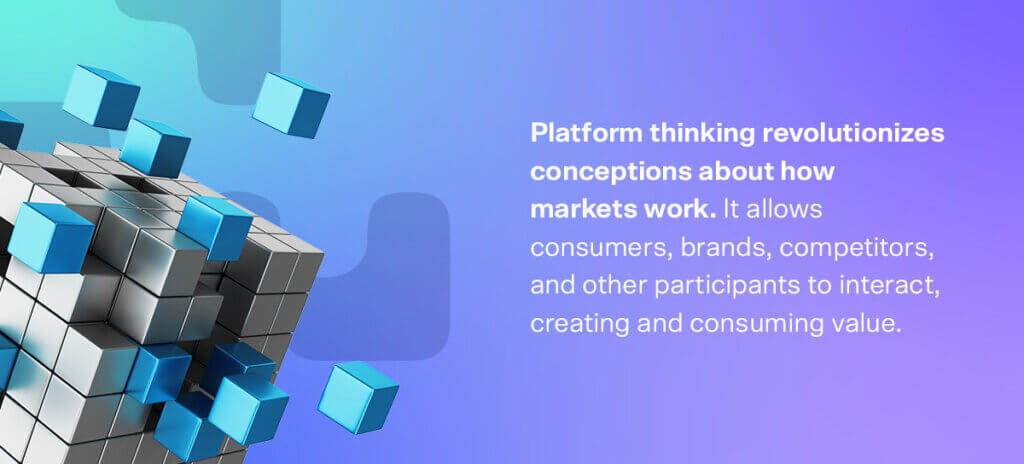Platform thinking in today’s business landscape redefines how markets work. While the concept has been around for decades, digital tools have magnified its impact, changing how consumers, brands, and their competitors interact and create value. Many top companies worldwide have mastered platform thinking, reimagining the concept of supply and demand and empowering people at every stage of the customer journey to change a brand’s trajectory, reach more people, and foster a culture of innovation.
Diving Deep Into the Concept of Platform Thinking
At its core, platform thinking is about transforming consumers from passive to proactive participants in the product lifestyle. It allows us to engage in the value-creation lifecycle. The concept of platforms is not new, but it takes on new meaning in today’s rapidly evolving business landscape. While “platform” is common in several contexts, platform thinking hinges on one fundamental principle — building a collaborative ecosystem that provides shared benefits.
Agility and innovation are critical aspects of business today, and platform thinking fosters both, creating an empowered, proactive network of people benefitting from different business contexts. In practical terms, a platform accelerates growth through shared tools, processes, people, and data. The concept of platform thinking continues to take on new meaning as digital technology becomes increasingly flexible, allowing businesses to innovate, integrate, and deploy new offerings.
Unraveling the Definition and Origins of Platform Thinking
A concrete definition of platform thinking is a matter of some debate. A platform is best described as the orchestrator of a digital ecosystem, linking people, businesses, and resources for mutually beneficial outcomes.
Traditional market thinking involves producers and consumers. In a linear model, producers create value by optimizing their core activities. They create a competitive advantage by differentiating their activities. Customers are happy to pay a price for the value producers create. This “pipeline thinking” is linear. Businesses compete by controlling and adding value along the pipeline. While it’s served us well in the past, the pipeline leaves you open to the risk of being left behind in an evolving digital landscape.

Platform thinking revolutionizes conceptions about how markets work. It allows consumers, brands, competitors, and other participants to interact, creating and consuming value. Consumers are no longer mere recipients of created value. They are active participants, producing their own value as part of a significant digital ecosystem. Value is created through collaboration, interaction, and participant engagement.
Unpacking the Core Principles of Platform Thinking
A platform business model exists if there is a single group of producers and consumers. Think of Uber. The riders and drivers are the participants. Uber orchestrates the value participants create through rules and best practices. Airbnb is another example. The participants are hosts and travelers. Platform thinking, then, is an open architecture with rules of governance designed to support interactions. With multiple producers and consumers, this business model becomes a digital ecosystem.
An ecosystem consists of digitally connected organizations that are enabled by modularity. Remove the hierarchy and provide adjacent products or services by collaborating with other business units, and you have a platform. Some of the core principles of platform thinking include:
- Share data generated on the platform: Uber is an excellent example. They entered food delivery, adding restaurants as new participants in the Uber ecosystem. Applying the data and analytics to the massive volume of transactions optimizes the platform ecosystem, keeping it agile despite changing consumer demands and reinvigorating value creation.
- Change the nature of competition: A digital ecosystem shifts the focus from the firm to the ecosystem. Strategically, you can create and orchestrate an ecosystem or join it to an existing ecosystem. Android and Apple ecosystems are prime examples of ecosystem competition.
- Remove friction: Platform thinking operates on the premise that the platform delivers shared value beyond platform owners or ecosystem partners. It creates new value instead of solving existing problems more efficiently, removing friction from the market through business agility.
- Facilitate interactions over transactions: The interaction field is another form of platform thinking, feeding on continuous participation and collaboration between multiple groups. Unlike transactions like booking an Uber, the interaction field delivers shared value to everyone.
Appreciating the Significance of Platform Thinking in the Contemporary Business Landscape
Flatiron Health, a Roche Pharma company, has enabled an interaction field that connects patients, health care professionals, regulators like the Food and Drug Administration (FDA), and even competitors in a continuous interaction. Leveraging the interactions of millions of patients, health care professionals can share data about every instance of cancer treatment. Each interaction is rich with deep learning, enabling an extensive network of companies involved in every aspect of health care to collaborate with the FDA. This level of platform thinking results in earlier FDA approval for therapeutic solutions and more effective treatment for cancer patients.
One similarity in platform thinking business models in recent years is the creation of value through three principal effects:
- Network effects: Products or services become more valuable as more people join and contribute. Think Airbnb. The more people worldwide who offer their space to travelers, the more valuable the service becomes. Travelers have options, no matter where they are.
- Virality: As people experience the platform’s value, they become voluntary advocates, encouraging others to experience the same effect
- Learning effects: The product becomes more valuable as the brand applies human knowledge and AI to the vast data the platform collects.
Platform Thinking: A Revolutionary Approach to Customer-Centricity
Platform thinking places the consumers at the center of your journey and theirs. Its central task is to allow users to benefit from each other’s presence. Platform strategy breaks down the assumption that consumers are independently responsible for purchasing. Instead, their participation is interdependent with others’ choices.
Understanding the Platform Strategy Approach

Devising an effective platform strategy requires a culture of innovation, a clear vision, and defined tools to create, capture, and deliver value. As technology evolves, so do opportunities for providing value and boosting accessibility. The platform strategy approach involves integrating digital platforms with strategic goals and defining how they work together to create value. Start with a clear leadership vision. Determine the types of digital platforms to develop and consider the best method to deliver your services, and you have the beginnings of a strategy that can transcend rapid market changes.
Redefining the Delivery of Business Value Through Platform Thinking
A successful platform starts with the customer. It recognizes and connects with a need and reimagines ways to meet it better than what already exists. Platform thinking redefines what your business can achieve. It accelerates delivery, enables the sharing of critical business capabilities, and supports experimentation, reinvigorating your company with every shift in market trends.
As relationships are the central hub of this business strategy, and you’re setting the rules, you can transform communities, previously a source of demand, into meaningful connections. Unlock the power of data, and you have a potent collaborative engine to power your innovations.
Empowering Your Workforce With Platform Thinking
Innovation is collaborative. Platform thinking unleashes the full power of collaboration. A platform strategy streamlines your operational processes and gives you room to innovate without additional costs. Instead, you can reimagine your assets, reduce friction in development and delivery, and support a culture of innovation. In short, you’re integrating state-of-the-art technology with a collaborative team, and the results are transformative.
Go beyond setting goals and find objectives you have yet to consider. Encourage creativity while minimizing risks. Communicate with your target audience in real time and empower your teams to test the boundaries of innovation. Blend imagination with real-time consumer data to stay ahead of trends, boosting your agility in the ever-changing business space.
Reinvent Your Brand With Vivaldi Group
Creating value and harnessing the power of technology are essential to remain relevant in today’s evolving business landscape. Vivaldi has been creating transformational growth through radical consumer-centricity, helping you reimagine your brand from the inside-out since 1999. Foster large-scale collaborations and develop a culture of agile innovation with us. Speak to one of our experts today to learn more.

